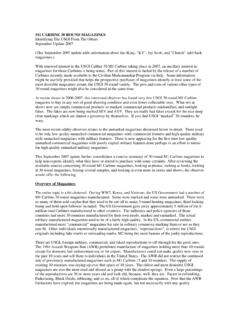Transcription of Magazine Covers and Cover Lines: An Illustrated History
1 Magazine Covers and Cover Lines: An Illustrated History Journal of Magazine & New Media Research Vol. 5, No. 1 Fall 2002 1 Magazine Covers and Cover Lines: An Illustrated History Gerald Grow, , Florida A&M University Over time, Magazine Covers have changed radically, and that change can be observed by following how magazines used Cover lines. This article traces the History of Magazine Cover lines from early, bookish designs, through the emergence of the poster Cover and its dominance, through the integration of type with art, to the proliferation of Cover lines at the beginning of the 21st century.
2 In the mid-1700s, the earliest magazines did not always have what we think of as Covers . Many dedicated the opening page to a title and table of contents, as in this Cover of The Town and Country Magazine ; or Universal Repository; of Knowledge, Instruction, and Entertainment for April, 1788. When early magazines used Covers , they tended to model them after the Covers of books -- providing only a title and publication data. There were no descriptive words indicating what would be found inside the Magazine .
3 The Cover of the American Magazine of Useful and Entertaining Knowledge from 1835 shows a centered, formal balance and book-like layout, with a small illustration that appears to have a decorative purpose, rather than to illustrate the contents. The table-of-contents Cover and the book-like Cover co-existed through the 1700s and 1800s. Magazine Covers and Cover Lines: An Illustrated History Journal of Magazine & New Media Research Vol.
4 5, No. 1 Fall 2002 2 Mother's Magazine from1844 is an example of a third kind of Cover that was common in the first two centuries of magazines -- the symbolic Cover . It uses a generic illustration in a symbolic manner to evoke the spirit of the publication, without revealing any of this issue's specific contents. The Magazine picture might be seen as telling the readers of Mother's Magazine that they are the foundation, the pillars, the unifying arch, the source and fountain, the life, and the instructor of their families.
5 All of those implications can be reasonably found in its stylized picture, if you remember that earlier generations customarily read the Bible, and pictures, as allegorical messages requiring active interpretation. Such generic Covers appeared, as in this example, without any Cover lines indicating the contents, or, at times, with a line or two unobtrusively tucked under the standard design. Cover lines were not only rare in early magazines, but many had no Covers . Like newspapers, they began an article on the front page, as in this Penny Magazine from 1838.
6 Cover lines began to appear within such generic Covers in the later 1800s. The popular Peterson's women's Magazine of 1872 uses a completely generic Cover richly decorated with the leafy symmetry of Victorian embellishments, with a lovely assemblage of drawings at the bottom symbolizing the various roles of woman in the family. But in this case, the generic has been infiltrated by the specific: The top of the Magazine makes the modestly startling announcement of one of the topics to be found inside: "Now is the time to make up clubs.
7 " Magazine Covers and Cover Lines: An Illustrated History Journal of Magazine & New Media Research Vol. 5, No. 1 Fall 2002 3 Cosmopolitan of 1893 illustrates a common way magazines of that period used the Cover to convey the table of contents, a Cover line or two (here, at the top), and the Magazine 's identity (the characteristic large "C" and red band). Reader's Digest used the table of contents as its Cover from 1922 till 1998, and it is a still used as a Cover design by many journals and literary magazines.
8 Chaperone from 1896 illustrates the kind of experimentation that was taking place in Cover design during the latter 1800s. This issue prints a small generic illustration surrounded by coin-like circles labeled with the name of the departments inside the Magazine -- Art, Music, Literature, Science, Outings, Dress, Humor, etc. -- rather than the contents of actual articles. The end of the 19th century found a wide range of Magazine Covers at play, many of them beginning to work with two questions that would occupy Magazine designers for the next hundred years: Should we use Cover lines?
9 If so, how many, and where should we put them? Magazine Covers and Cover Lines: An Illustrated History Journal of Magazine & New Media Research Vol. 5, No. 1 Fall 2002 4 II. The Poster Cover : Pictures That Need No Words From the 1890s to the 1960s, one type of Cover could be said to dominate the Magazine field. It was not the only kind of Cover to be found, but the poster Cover produced so many memorable Covers on so many issues of so many magazines that it is sometimes looked upon as the standard against which all other kinds of Covers must be measured.
10 Outstanding professional illustrators emerged in the late 1800s. Many learned their craft from the artistic posters of the Art Norveau movement (some, like the works of Mucha, have remained standard items in the interior decorator's catalog). Their work -- conveyed onto the page with the aid of a small army of skilled engravers -- dominated graphic design, even though excellent photographs existed at the time. By the early 1900s, several illustrators, including Charles Dana Gibson and Maxfield Parrish, had become nationally famous; their work not only appeared on many Magazine Covers , but they received Cover billing for work that appeared inside.









